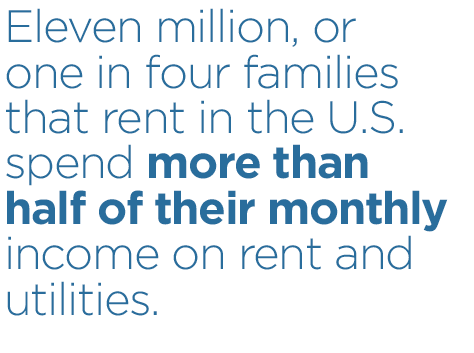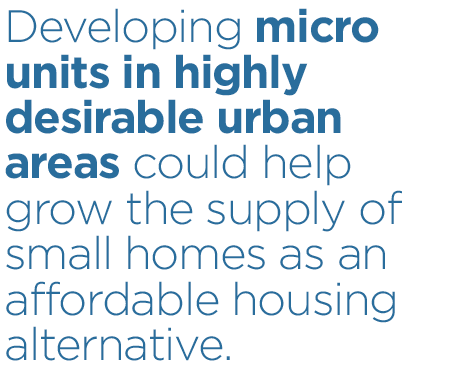With homeownership levels at their lowest point in 50 years, the demand for multifamily rental homes is booming. Recently, the Urban Institute released a study that suggests 59 percent of new household formation over the next 15 years will be renters, which will cause an even bigger surge in the demand for rental housing. But are we prepared to meet this increased need?
To meet the growing demand for rental housing, we must address both the availability and affordability of supply. While the pace of new construction has picked up in recent years, it’s not yet at a level to meet new household demand. Also, it’s important to consider the simultaneous loss of inventory occurring. The national rental vacancy rate dipped to 7.6 percent in 2014, its lowest point in nearly 20 years, according to the Joint Center for Housing Studies of Harvard University’s “State of the Nation’s Housing 2015” study (JCHS study). And each year, a large number of affordable rental units are lost from the housing supply due to demolition, deterioration of aging properties, expiring federal contracts and affordability controls and conversion to condos.
Most new rental housing development currently falls into the high-end category, with the median asking rent equaling $1,290 in 2013, or about half of the typical renter’s monthly household income, says the JCHS study. But this high-end development will not be accessible to the people who need it most: those who are either choosing to rent (i.e., young adults) or forced to rent because homeownership is becoming ever more out of reach. Eleven million, or one in four families that rent in the U.S. spend more than half of their monthly income on rent and utilities, according to an analysis of Census data by Enterprise Community Partners’ Make Room campaign, making saving for a down payment—let alone paying for necessities—nearly impossible. Currently, there is very little multifamily development happening for low- to middle-income renters, including Millennials, seniors and minorities, who in the coming years will need affordable multifamily units more than ever before.
 Knowing the situation in store is only one small step towards preparing to meet future rental housing demands. While there won’t be a silver-bullet solution to solve the rental housing shortage around the country, there are initial actions we can, and should, take in the multifamily space to enable us to adapt effectively to the landscape ahead and ensure that we are meeting the needs and desires of residents in regard to the availability and affordability of units.
Knowing the situation in store is only one small step towards preparing to meet future rental housing demands. While there won’t be a silver-bullet solution to solve the rental housing shortage around the country, there are initial actions we can, and should, take in the multifamily space to enable us to adapt effectively to the landscape ahead and ensure that we are meeting the needs and desires of residents in regard to the availability and affordability of units.
1) Federal, state and local governments should consider targeting subsidies and assistance not only to low-income renters, but also toward middle-income renters. While an increasing share of moderate- and middle-income households are rent burdened—spending more than 30 percent of their income on rent and utilities—these households are not well-served by existing housing subsidies, which are designed for low-income households, or those earning less than 60 percent of Area Median Income (AMI). Over the coming years, we should begin to see the conversation around subsidies change by incorporating the workforce segment, which is being increasingly forced out of the market, and more attention paid to new programs that help meet their needs.
2) Local governments must embrace the new development of rental properties. As part of this, they should potentially consider taking action to reduce the costs associated with new construction, particularly for affordable and workforce housing. Recommendations suggested in “Bending the Cost Curve: Solutions to Expand the Supply of Affordable Rentals,” a joint report by Enterprise Community Partners and the ULI Terwilliger Center for Housing, include: improving and coordinating building codes, zoning and regulation; providing local incentives for affordable housing development, such as subsidizing land or infrastructure costs; and creating public/private partnerships to provide capital for smaller projects that may not otherwise have financing available.
 3) Developing micro units in highly desirable urban areas could help grow the supply of small homes as an affordable housing alternative. As more renters choose to rent for longer, and a growing number of renting Millennials on a budget opt for proximity to city centers over space, the demand for micro units will likely increase. In fact, according to the Urban Institute, when Millennials have reached their prime home buying age in 2030, only 38 percent will own homes compared with 46 percent of baby boomers in the 1990s. The jury is still out on exactly how widespread this development will become. Micro units primarily (and will continue to) serve Millennial renters and will be a less practical solution for other segments of the market, including retirees or families. However, the units do help in addressing the supply issue for a portion of the market that will rent for longer than the generation before them.
3) Developing micro units in highly desirable urban areas could help grow the supply of small homes as an affordable housing alternative. As more renters choose to rent for longer, and a growing number of renting Millennials on a budget opt for proximity to city centers over space, the demand for micro units will likely increase. In fact, according to the Urban Institute, when Millennials have reached their prime home buying age in 2030, only 38 percent will own homes compared with 46 percent of baby boomers in the 1990s. The jury is still out on exactly how widespread this development will become. Micro units primarily (and will continue to) serve Millennial renters and will be a less practical solution for other segments of the market, including retirees or families. However, the units do help in addressing the supply issue for a portion of the market that will rent for longer than the generation before them.
4) Beyond new construction, it is critical that we focus our attention on the preservation and rehabilitation of existing, aging inventory in urban areas where demand is especially high. More than half of the affordable rental units on the market are in smaller buildings (made up of 10 units or less) and tend to be older stock. Generally, these properties are owned by small, local landlords, so part of the challenge in preserving this inventory in both urban and rural areas is effectively educating owners and managers about property upkeep. Additionally, we must take steps to ensure that capital is in sufficient supply and reasonably accessible to help maintain these units. Encouraging the rehabilitation of this inventory as a way to maintain safe, sanitary, affordable housing makes maintenance easier and less cost-prohibitive for owners.
With demand for multifamily rentals only projected to increase over the next 15 years, now is the time to begin thinking about the future of multifamily housing in the United States. Beyond unit availability, it’s crucial that we focus our attention on the issue of affordability for low-, moderate- and middle-income renters. This article will be the first in a series of pieces addressing the evolving state of multifamily housing in the country. Over the coming months, we’ll explore the changing landscape and developments geared toward meeting the needs of renters.

